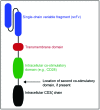Harnessing the immune system in the battle against breast cancer
- PMID: 29456568
- PMCID: PMC5810622
- DOI: 10.7573/dic.212520
Harnessing the immune system in the battle against breast cancer
Abstract
Breast cancer is the most prevalent malignancy in women and the second most common cause of cancer-related death worldwide. Despite major innovations in early detection and advanced therapeutics, up to 30% of women with node-negative breast cancer and 70% of women with node-positive breast cancer will develop recurrence. The recognition that breast tumors are infiltrated by a complex array of immune cells that influence their development, progression, and metastasis, as well as their responsiveness to systemic therapies has sparked major interest in the development of immunotherapies. In fact, not only the native host immune system can be altered to promote potent antitumor response, but also its components can be manipulated to generate effective therapeutic strategies. We present here a review of the major approaches to immunotherapy in breast cancers, both successes and failures, as well as new therapies on the horizon.
Keywords: adoptive transfer; breast cancer; cancer vaccine; cytokines; immunomodulation; immunotherapy; monoclonal antibody; oncolytic virotherapy.
Conflict of interest statement
Disclosure and potential conflicts of interest: The authors have declared that there are no conflicts of interest. The International Committee of Medical Journal Editors (ICMJE) Potential Conflicts of Interests form for the authors are available for download at: http://www.drugsincontext.com/wp-content/uploads/2018/01/dic.212520-COI.pdf
Figures


Similar articles
-
Heterologous prime-boost cellular vaccination induces potent antitumor immunity against triple negative breast cancer.Front Immunol. 2023 Feb 13;14:1098344. doi: 10.3389/fimmu.2023.1098344. eCollection 2023. Front Immunol. 2023. PMID: 36860852 Free PMC article.
-
Immunotherapy Resistance in Glioblastoma.Front Genet. 2021 Dec 17;12:750675. doi: 10.3389/fgene.2021.750675. eCollection 2021. Front Genet. 2021. PMID: 34976006 Free PMC article. Review.
-
The viral approach to breast cancer immunotherapy.J Cell Physiol. 2019 Feb;234(2):1257-1267. doi: 10.1002/jcp.27150. Epub 2018 Aug 26. J Cell Physiol. 2019. PMID: 30146692 Review.
-
Phenotypic profile of dendritic and T cells in the lymph node of Balb/C mice with breast cancer submitted to dendritic cells immunotherapy.Immunol Lett. 2016 Sep;177:25-37. doi: 10.1016/j.imlet.2016.07.009. Epub 2016 Jul 14. Immunol Lett. 2016. PMID: 27423825
-
Current and Future Applications of Novel Immunotherapies in Urological Oncology: A Critical Review of the Literature.Eur Urol Focus. 2018 Apr;4(3):442-454. doi: 10.1016/j.euf.2017.10.001. Epub 2017 Oct 19. Eur Urol Focus. 2018. PMID: 29056275 Review.
Cited by
-
Insight into the Crosstalk between Photodynamic Therapy and Immunotherapy in Breast Cancer.Cancers (Basel). 2023 Feb 28;15(5):1532. doi: 10.3390/cancers15051532. Cancers (Basel). 2023. PMID: 36900322 Free PMC article. Review.
-
Investigating tumor immunogenicity in breast cancer: deciphering the tumor immune response to enhance therapeutic approaches.Front Immunol. 2024 Oct 23;15:1399754. doi: 10.3389/fimmu.2024.1399754. eCollection 2024. Front Immunol. 2024. PMID: 39507526 Free PMC article. Review.
-
Pretreatment Leukocyte Count Ratios as Metastatic Predictive Factors in Luminal Type Breast Cancer.Asian Pac J Cancer Prev. 2022 May 1;23(5):1595-1601. doi: 10.31557/APJCP.2022.23.5.1595. Asian Pac J Cancer Prev. 2022. PMID: 35633543 Free PMC article.
-
Moving Breast Cancer Therapy up a Notch.Front Oncol. 2018 Nov 20;8:518. doi: 10.3389/fonc.2018.00518. eCollection 2018. Front Oncol. 2018. PMID: 30515368 Free PMC article. Review.
-
Bioinformatic profiling of prognosis-related genes in the breast cancer immune microenvironment.Aging (Albany NY). 2019 Nov 12;11(21):9328-9347. doi: 10.18632/aging.102373. Epub 2019 Nov 12. Aging (Albany NY). 2019. PMID: 31715586 Free PMC article.
References
-
- Sledge GW, Mamounas EP, Hortobagyi GN, Burstein HJ, Goodwin PJ, Wolff AC. Past, present, and future challenges in breast cancer treatment. J Clin Oncol. 2016;32:1979–86. http://dx.doi.org/10.1200/JCO.2014.55.4139. - DOI - PMC - PubMed
-
- DeSantis C, Ma J, Bryan L, Jemal A. Breast cancer statistics, 2013. CA Cancer J Clin. 2014;64:52–62. http://dx.doi.org/10.3322/caac.21203. - DOI - PubMed
-
- DeSantis CE, Ma J, Goding Sauer A, Newman LA, Jemal A. Breast cancer statistics, 2017, racial disparity in mortality by state. CA Cancer J Clin. 2017;67(6):439–48. http://dx.doi.org/10.3322/caac.21412. - DOI - PubMed
-
- Siegel RL, Miller KD, Jemal A. Cancer statistics, 2017. CA Cancer J Clin. 2017;67:7–30. http://dx.doi.org/10.3322/caac.21387. - DOI - PubMed
-
- Cardoso F, Harbeck N, Fallowfield L, Kyriakides S, Senkus E ESMO Guidelines Working Group. Locally recurrent or metastatic breast cancer: ESMO Clinical Practice Guidelines for diagnosis, treatment and follow-up. Ann Oncol. 2012;23:vii11–vii19. http://dx.doi.org/10.1093/annonc/mds232. - DOI - PubMed
Publication types
LinkOut - more resources
Full Text Sources
Other Literature Sources

